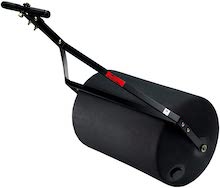Smooth out a Bumpy Lawn
Many families like to spend time in their yard. Playing yard games, running around, or even just having a bonfire with friends. However, these fun activities can become inconvenient or even dangerous with a bumpy lawn. Because of this, it is incredibly important to maintain your yard, creating a smooth and even lawn for maximum enjoyment.
 How do you smooth out a bumpy lawn? Today, we will be sharing several quick tips and fixes for making your lawn less bumpy. A few of these include:
How do you smooth out a bumpy lawn? Today, we will be sharing several quick tips and fixes for making your lawn less bumpy. A few of these include:
- Topdressing to Level Your Lawn
- Rolling Your Lawn
- Tamping Your Lawn
- Leveling and Replanting Your Sod
- Start the Lawn From Seed
- Replacing Missing Dirt Under Your Sod
By using one of the methods listed above, you will be able to guarantee that your lawn is free of bumps. This creates a safe and enjoyable atmosphere for both you and your loved ones.
Although these methods for smoothing your lawn sound simple enough, there are actually several factors that should be considered while deciding on your preferred method. Using the wrong lawn smoothing technique can be ineffective or even cause further damage to your yard.
Quick Fixes to Smooth Out Your Bumpy Lawn
Luckily, there are several quick tips and fixes for making your lawn less bumpy! The method you choose will depend greatly on your individual situation and how rough your lawn is. The preferred method will also be dictated by the type of lawn you have, either sod or grass seed.
1. Level Out Your Lawn by Topdressing
Perhaps the most common method of making your lawn less bumpy is topdressing. Leveling your yard by topdressing is rather simple, although it can be time-consuming. Topdressing is also the preferred method used by lawn care professionals.
The use of the topdressing method is most beneficial when the bumps in your lawn are less drastic. Topdressing is also the most effective method for preventing serious bumps in the future.
How do you level a top dress lawn?
First, cut your lawn at the shortest setting. This will allow you to see where the bumps are located and how deep they are. Next, use a high-quality fill material to fill in the bumps. For most situations, it is recommended to only use ¼” layers to prevent further shifting.
Use a rake or other yard tool to gently sweep the fill material into the cracks between the grass. Allow the grass to recover and then repeat the process until your yard is level once again.
2. Rolling Your Lawn
Should I Roll My Lawn?
Only in situations where the bumps in your lawn are caused by moles or other pests, rolling your lawn may be the best method for leveling. It is important that you practice caution while rolling your lawn.
Although rolling your lawn is the quickest method of smoothing the bumps, it will not be permanently effective until your yard is rid of the dogs and other pests. This can be done using traps or through a professional extermination company. It is best to trap the pests before attempting to smooth the bumps in your yard.
Is Rolling My Lawn Good for It?
Rolling the lawn excessively will compact the soil, creating thin, unhealthy grass in the long run. Rolling a healthy lawn can also damage the grass on the surface and in turn destroy the root system underneath. Lawn rolling should only be done in specific situations to help flatten the soil underneath.
Does a lawn roller Really Work?
Yes, when used properly. A lawn roller is most effective when rolling the soil before laying fresh sod. A lawn roller is also beneficial in situations where newly laid sod has begun to settle. However, be sure the soil beneath the sod is still soft. It is unwise to use a heavy lawn roller on newly laid sod with hard soil underneath as it can cause irreversible damage.
3. Tamping Your Lawn
Tamping your lawn is similar in many ways to rolling. A tamper is a heavy, flat piece of metal with a handle attached to it. Using this tool, one pushes the bumps back into the ground to create a level lawn.
Tamping the lawn only effective if it is done while the soil is soft. If you are attempting to tamp the bumps in your established lawn, it is recommended to get the soil wet. However, be careful to not add too much water as this can cause you to create deeper holes.
4. Lay New Sod in Trouble Spots
In some situations, the best course of action is to simply lay new sod in the trouble spots. If you have an area of your lawn that is particularly bumpy, it may be more cost- and time-effective to law new sod.
Rough, bumpy patches could be due to improper installation of the sod. Because of this, it will be rather time-consuming to level the bumps. If the bumps are localized to a certain part of your yard, this is most likely the case.
Once you remove the original sod, be careful to level the soil beneath before laying the new sod. Being especially diligent during this step will eliminate future problems from occurring.
5. Start the Lawn From Seed
If your lawn was planted from grass seed instead of sod, replacing the grass will not be quite as simple. However, in some cases, it is beneficial to start your lawn from seed. Although it can be rather inconvenient, reseeding the lawn after leveling the soil can produce incredible results!
Killing the grass and weeds that cover your lawn and starting from scratch is commonly called renovation. If this is the method you choose for making your lawn less bumpy, it is advised that you let the soil settle before replanting your yard with new grass seed. This will allow you to ensure that you have a clean slate.
6. Replacing Missing Dirt Under Sod
Sometimes, you may be able to quickly solve the bumps in your lawn by simply replacing the dirt that is missing underneath your sod! Some people refer to this practice as “sweeping dirt under the carpet”. This method is generally best in situations where the bumps are too drastic to be fixed by topdressing.
In this quick fix for making your lawn less bumpy, carefully lift up the sod in the rough, bumpy area. If the bumpy area is large, cut the sod in small manageable sections to avoid damage. Next, use a high-quality fill material to fill in any holes. Use a rake or shovel to level out any bumps, creating a smooth, level surface.
Add water to the fill material to allow the soil to settle. This will prevent new holes from forming due to air pockets or unsettled soil. Finally, carefully replace the sod that was removed. Allow the grass to repair itself for a few weeks before putting unnecessary strain on that specific area.

Should You Fix Your Bumpy Lawn?
There are several reasons for fixing your bumpy lawn. A smooth lawn provides more opportunities for fun activities and yard games. Most importantly, it ensures the safety of your family and friends.
If your lawn is bumpy, you know how frustrating it can be to play yard games. Bumps and holes throughout the yard cause balls to get stuck. Sometimes the equipment needed for the game is unable to stand up due to a bumpy lawn. This takes the enjoyment out of a very fun afternoon.
However, a bumpy lawn is more than just an afternoon inconvenience. Faulty rainwater drainage or pests can be the cause of the bumps in your lawn. Either of these causes could wreak significant havoc on the rest of your yard or even on your home.
Additionally, a bumpy lawn poses a serious danger to your family friends, especially the children and elderly. Failing to fix the bumps in your lawn can cause a loved one to trip and fall. In some cases, a fall like this can lead to serious injury.
For all the reasons listed above, as well as others, we believe that it is crucial to fix the bumps in your lawn. Maintaining your yard properly each year will prevent you from needing to take drastic measures to fix a serious issue down the road. This saves you time, money, and unnecessary frustration.
What Causes Bumpy Lawns?
There are many causes for bumpy lawns. However, the most common issues are:
- Faulty Drainage System
- Shifting Soil Under Your Lawn
- Changes in Temperature
- Unwanted Pests
No matter the cause of your bumpy lawn, it is wise to take precautionary measures to prevent further damage. By maintaining your yard carefully each season, you will eliminate the potential for a bumpy lawn. This routine lawn maintenance includes regular watering, raking, mowing, and fertilizing.
Final Thoughts
As you can see, there are several ways to quickly fix your bumpy lawn. By practicing proper lawn maintenance, as well as leveling bumps as they arise, you will eliminate the need for drastic repair measures.
Depending on how bumpy your lawn is, it may be beneficial to consult with a lawn care professional. In any case, it is important to consider your options when deciding which method is best for your situation. Attempting to use the wrong lawn repair method can result in further, irreversible damage to your yard.
Eliminating the bumps in your lawn and creating a smooth, soft yard is an important part of home maintenance. By ridding your lawn of bumps, you will not only create an aesthetically pleasing yard but also ensure the safety of your family and friends.



